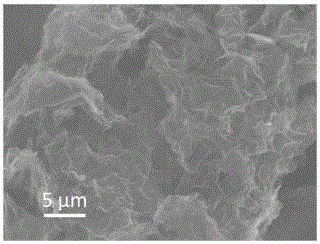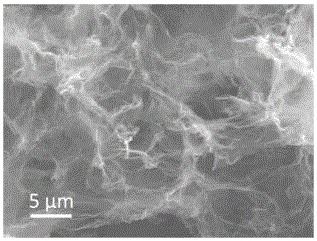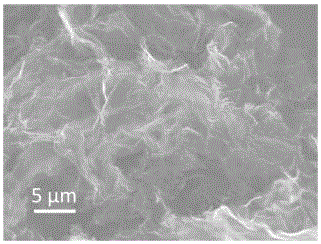Preparation method and application of iodine-doped graphene
A graphene and iodine doping technology, applied in the field of materials, can solve the problems of reduced electrical conductivity, insufficient contact between electrolyte and materials, and unsatisfactory electrochemical performance.
- Summary
- Abstract
- Description
- Claims
- Application Information
AI Technical Summary
Problems solved by technology
Method used
Image
Examples
preparation example Construction
[0028] A preparation method for iodine-doped graphene, comprising the following steps:
[0029] S1 Dissolve the iodine source in deionized water to prepare a solution I with a certain concentration;
[0030] S2 Prepare a certain concentration of graphene oxide suspension and add it to solution I. The mass ratio of graphene oxide in the graphene oxide suspension to iodide anions in solution I is 1:4 to 1:60, and mix well. Formation of mixed liquid II;
[0031] S3 Treat the mixed solution II with ultrasonic waves for 3-6 minutes;
[0032] S4 is transferred to a high-pressure reactor with a polytetrafluoroethylene liner for hydrothermal reaction at a temperature of 150°C to 200°C for 10 to 14 hours to reduce graphene oxide to graphene, and at the same time dope iodine into graphite In ene, adjust the layer spacing of graphene;
[0033] S5 washing the obtained product several times with deionized water, removing excess salt therein, and freeze-drying to obtain iodine-doped grap...
Embodiment 1
[0035] Example 1: Weigh 0.375 g of sodium iodide and dissolve it in 28 ml of deionized water, then add 12 ml of graphene oxide suspension (4.2 mg ml-1) into the solution, ultrasonicate for 5 min, and mix The solution was transferred to a 50 ml polytetrafluoroethylene liner autoclave, and reacted at 180 °C for 12 h. The resulting product was washed several times with deionized water to remove excess salt, and then freeze-dried to obtain iodine-doped composites of graphene. For the scanning electron microscope image of the prepared doped graphene, please refer to figure 1 , it can be seen from the figure that the iodine-doped graphene is relatively loose.
Embodiment 2
[0036] Example 2: Weigh 0.75 g of sodium iodide and dissolve it in 28 ml of deionized water, then add 12 ml of graphene oxide suspension (4.2 mg ml-1) into the solution, ultrasonicate for 5 min, and mix The solution was transferred to a 50 ml polytetrafluoroethylene liner autoclave, and reacted at 180 °C for 12 h. The resulting product was washed several times with deionized water to remove excess salt, and then freeze-dried to obtain iodine-doped composites of graphene. For the scanning electron microscope image of the prepared doped graphene, please refer to figure 2 , it can be seen from the figure that the iodine-doped graphene is relatively loose and wrinkled.
PUM
 Login to View More
Login to View More Abstract
Description
Claims
Application Information
 Login to View More
Login to View More - R&D
- Intellectual Property
- Life Sciences
- Materials
- Tech Scout
- Unparalleled Data Quality
- Higher Quality Content
- 60% Fewer Hallucinations
Browse by: Latest US Patents, China's latest patents, Technical Efficacy Thesaurus, Application Domain, Technology Topic, Popular Technical Reports.
© 2025 PatSnap. All rights reserved.Legal|Privacy policy|Modern Slavery Act Transparency Statement|Sitemap|About US| Contact US: help@patsnap.com



